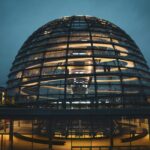The cancellation of Romania’s presidential elections in December 2024 and the decision to reschedule them for May 2025 raised serious concerns both at home and abroad.
At first glance, this unprecedented move might suggest a breakdown of democracy. But while Romania is undoubtedly facing a turbulent moment, the reality is more nuanced. Beneath the institutional chaos, the country’s democratic and institutional foundations have proven more resilient than many assume.
It is crucial to distinguish between poorly explained election interference and the outright absence of electoral integrity and respect for democratic norms.
The December 2024 presidential election, following on the heels of successful local, parliamentary and European parliamentary elections the same year, was marred by an institutional failure that should never have happened and by Romania’s recurring weakness in strategic communication (seen also during the Covid-19 pandemic).
Romanian institutions must do far better to justify their existence before the public. The delayed explanations for the election’s annulment—coming in February and March rather than December—only deepened suspicions. However, despite the opacity, the explanations did come, marking an important step toward accountability.
At the core of what happened last year—without dismissing foreign interference and the role of anti-democratic political and ideological entrepreneurs—is the failure of mainstream political parties to understand, legitimise and address the public’s grievances.
Instead of addressing these concerns, they responded with self-sufficiency and arrogance. This failure is best exemplified by former President Klaus Iohannis, whose lack of leadership was on full display.
His presidency was defined by complacency, detachment, and a preference for pomp and luxury over governance. When faced with Romania’s political crisis, he managed it as ineffectively as his ill-fated NATO leadership campaign—so poorly that even President Donald Trump reportedly dismissed him outright.
Resilience in difficult times
Despite these challenges and the shortcomings of mainstream politicians, Romania’s institutions have endured under immense stress, proving their resilience even in extraordinary circumstances.
The legitimacy and goodwill afforded by decades of successful elections and peaceful transfers of power, with the backdrop of growing prosperity and functionality, have proven stronger than either the delegitimising efforts of frustrated politicians or the high-handed bumbling of the country’s leadership when faced with a challenge from out of left field.
The precise nature of the alleged Russian interference in the presidential election remains to be further determined and explained to both domestic and foreign audiences.
However, one thing is evident to American observers: it is impossible to run a legitimate campaign with zero spending, as was the claimed case for the banned radical-right candidate Călin Georgescu.
His doubling down on the idea of spontaneous coordination by individual volunteers to advance a highly professional campaign is even more ludicrous. Moreover, his highly controversial current and past statements on NATO and EU membership, military spending, F-35 acquisitions, and the presence of US bases in Romania have called into question some of Romania’s key foreign and defence policy pillars.
They have also raised eyebrows due to their striking similarity to Russia’s talking points, coupled with a strategy of rhetorical shifts in the Overton window, with appeals to ‘Russian wisdom’ or ‘the complicated history of Romania’s heroes’.
What we are witnessing is not a rejection of democracy or Romania’s Euro-Atlantic path—it is a revolt against a political mainstream that has failed to deliver and especially to inspire, and an exceptional, last-resort counter-reaction by Romanian institutions against a candidate who disregarded campaign financing rules and undermined key elements of the constitutional order.
Yes, the Constitutional Court may have taken an activist approach to protecting democracy, but Georgescu’s statements and actions—including his close association with Romanian mercenaries linked to Prigozhin’s Wagner group in Africa, about which he was caught lying—brought up more red flags than anyone had thought possible before the elections.
The public recognises this, as the weak nature of protests (remarked on by Georgescu himself) and the refrain from violence by all but paid agitators can attest. The electorate is wary but the political class has obviously been given a chance to explain itself and do things better.
The strength of the debates and strategising surrounding the May presidential elections is also encouraging—as philosopher Ernest Gellner once remarked, the true problems start when formal political contests are no longer seen as the way to advance one’s interests and resolve disputes.
The court of global opinion
Romania is one of the most pro-EU and pro-NATO countries in Europe, with over 80 per cent of the population supporting continued membership. However, the country’s international image has suffered, and rebuilding trust—both domestically and with strategic partners—will require significant effort.
It was not by how global audiences were primed for negative narratives by the decades of airing dirty laundry in public. This was a hallmark of Romanian reform efforts, but has done it no favours in the court of global opinion, despite the positive things implied by the strength of the discourse in the fight against corruption and the applicability of the rule of law even to the strongest in society.
The effort to rectify Romania’s image should not come in the form of punishing the Romanian people for the failures of their leadership and institutions. Those same Romanians have searched for a strategic partnership that would provide the stability and credible protection that the country’s location have historically required, but have also risen to the challenge of faithfully supporting Alliance activities, shouldering their due burden, enhancing military capabilities, and trying to become a regional security provider.
Rather, Romania must embark on the road to renormalisation, which will culminate in the May presidential election, and reaffirm its commitment to democratic values and stability.
Neither is the solution to be found in disengagement or a diminished American presence in Romania. On the contrary, Romanians have overwhelmingly welcomed the US presence, and Washington should recognise that Romania remains a steadfast and useful ally, and that its presence in Romania ensures a key node for global power projection.
Romania can emerge stronger
The events of 2024 need to be carefully explained, both to the Romanian public and to Romania’s American and European partners. Once Romania puts its house in order post-election, it must also launch an external charm offensive to restore credibility.
Importantly, Romania should not become another flashpoint or even a rhetorical football in the growing rift between the US and Western Europe, whose issues have been simmering since long before Eastern NATO expansion. None of the countries on the Eastern Flank want this.
Instead, Romania can take the lead in playing a constructive role in refocusing transatlantic relations on a foundation of enhanced security and equitable economic cooperation. The country has weathered a political storm, but it remains firmly anchored in the democratic and Western world.
With the right leadership and strategic recalibration, Romania can emerge stronger from this crisis—not just as a stable democracy, but as a key player in reinforcing the Euro-Atlantic alliance.
Photo by Calin Stan on Unsplash







